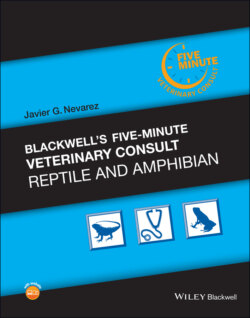Читать книгу Blackwell's Five-Minute Veterinary Consult: Reptile and Amphibian - Javier G. Nevarez - Страница 28
REPRODUCTION
ОглавлениеReproduction is regulated by the pineal gland, hypothalamus, and pituitary glands, which process environmental stimuli into hormonal changes. In temperate species, gonadal stimulation occurs by increased temperature and longer days while in tropical species increased food availability and rainfall provide gonadal stimulation.
Sex determination may be genotypic (ZZ are males, ZW are female) or temperature dependent. Temperature sex determination is not reported or well known in snakes but occurs in all the other reptile groups. In chelonians, high temperatures yield mostly females while low temperatures yield a majority of males. In most the lizards, temperature sex determination is opposite to chelonians. Some turtles and lizards will have a predominance of females at high and low temperatures and males at intermediate temperatures. For crocodilians, females occur at low temperature (28–30 degrees C) in all species. In caimans and alligators, male and females occur at 31–32 degrees C while males occur at 32–34 degrees C. In crocodiles, more males than females will occur at 31–33 degrees C, while the ratio is reversed at 33–34 degrees C.
The right gonad is located close to vena cava and connected to it by small vessels, while the left is associated with the left adrenal and has its own blood supply. In some male lizards, there is a single urodeum opening for the ureter and vas, while in other reptiles there are two separate openings.
The oviducts are responsible for egg transport and secretion of albumin, proteins, and calcium. The oviduct is divided from proximal to distal into the infundibulum, uterine tube, isthmus, uterus, and vagina. There is a three‐phase ovarian cycle comprising:
1 Quiescent stage—no follicular development.
2 Vitellogenic phase—rapid hypertrophy of the ovary and oviduct, yolk production, increased estrogen, and calcium mobilization.
3 Gravidity/pregnancy—during which fertilization and oviposition occur. Many species have a pre‐lay and/or a pre‐ovulatory shed.
Reptiles may be oviparous or viviparous. All chelonians and crocodilians, most lizards (iguanids, monitors, geckos), all pythons, and most colubrids are oviparous. Oviparous reptiles produce two to three clutches per season, with the yolk being the only source of nutrients for the embryo. All boas and vipers, some skinks and chameleons, the European lizard, and garter snakes are viviparous. Viviparous species maintain the corpus luteum for longer, and produce one clutch per year with a longer gestation time. Viviparous species have a more drastic decrease in body condition of the females because they provide direct nutrition to the embryos.
